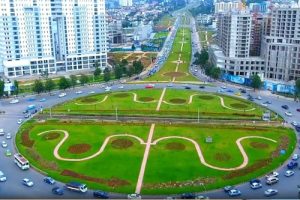
Ethiopia is endowed with abundant agricultural resources and has diverse ecological zones. Agriculture is the mainstay of the Ethiopian economy, accounting for around 35% of the country’s GDP and employing over 70% of the population.
The Government has identified key priority intervention areas to increase productivity of smallholder farms and expand large-scale commercial farms. Particularly, under the new administration has given renewed emphasis to develop the agriculture sector and ensure food security. Among the top priorities identified include: small and large-scale irrigations’ development, agricultural inputs supply financing, increasing productivity of crops and livestock, improving agricultural production methods using mechanization, post-harvest loss reduction, developing research-based food security system, and natural resources management.
Ethiopia has vast untapped water resources and arable land, but only about 5% of the country’s water resources are currently utilized for irrigation. Modernizing the agricultural sector without expanding irrigation farming and using modern inputs is considered impossible. While irrigation farming has been practiced traditionally in the highlands, more large-scale and modern irrigation systems were introduced in the 1950s in the Awash River valley for sugar cane cultivation by the Dutch company HVA Matahara. Additionally, large-scale irrigation farms were established in the northwestern parts of the country in the North Gondar Zone of Amhara region Metema and Humera for oilseed and cereal production. These irrigation-based commercial farms have played a pivotal role in supporting Ethiopia’s export earnings over the past decades.
In the last 30 years, small-scale irrigation farming has expanded to various parts of the country, but the full potential remains untapped due to issues like damage to water pumps and lack of spare parts. Nevertheless, the area under irrigation is steadily increasing over time. The Ministry of Irrigation and Lowlands has developed large and medium-scale irrigation schemes, but Ethiopia still vastly underutilizes its irrigation potential, which is key to realizing the country’s vision of becoming a middle-income economy by 2030.
The challenge that has to be solved to realize this vision is the question of ensuring food security and building climate resilience economy. If used effectively, irrigation technology is an option that can help solve this issue and have positive trickle-down effects across other sectors. However, this question is also tied with the farmers, pastoralists and semi-pastoralists populations in lowland areas of the country. These areas of Ethiopia have historically been underexplored despite the opportunities they may offer.
Therefore, harnessing the potential of cultivating irrigation farm in the lowland parts of the country further strengthen the nation efforts to boost exporting agricultural products.
Recently, the Ministry of Trade and Regional Integration announced that Ethiopia has obtained 617 million USD from exported products during the last 8 months of the current fiscal year. The Ministry stated that the amount achieved over the stated period is 87.51 % of the targeted 705.15 million USD. The revenue is obtained from export goods that have been supervised under the ministry. The income shows an increment of more than 80 million USD compared to the same period last year.
Most of the income is obtained from the export of cereals and oilseeds, the ministry said, indicating that improvement of demand for soybean, red beans and masho in the international market as well as an increase in sesame production and the implementation of agricultural investment regulation are the factors that contributed for the encouraging achievements.
According to the Ministry of Agriculture, agriculture is an essential driver of economic growth in the Ethiopian economy. Crop and livestock production account for roughly 65% and 25% of agricultural GDP respectively. Improved inputs, enhanced management techniques, and expansion of irrigation farming help to boost agricultural output. However, significant constraints, such as limited access to finance and technology, slow potential gains. Furthermore, inefficient market systems and underdeveloped research and extension services brought additional challenges.
Ethiopia has been an importer of agricultural goods despite this enormous potential. The government set a plan to replace wheat imports with local production by introducing irrigated farming techniques to harvest wheat twice a year. This will create great opportunities for foreign irrigation equipment manufacturers to supply their technology to the Ethiopian agricultural sector.
There are also three integrated agro-industrial processing parks and more planned for the years to come. Foreign companies that can supply equipment and technology for food processing plants have great opportunity in the Ethiopian market. The government policy also encourages foreign investors to engage in commercial farming in the selected areas of the country where the necessary infrastructure is availed.
Agri-investment licenses can be obtained from the Ethiopian Investment Commission and land can be leased for up to 99 years from regional and city administration bureaus. Recently, land allocation, compensation, and relocation have posed significant issues for the government in terms of equity and transparency.
In addition, significant regional autonomy in Ethiopia means that respect for land rights varies across the country. Ethiopia’s total agricultural exports in 2022 were valued at $3.3 billion. Major exports include: Coffee ($1.5 billion), Fresh-cut flowers ($591 million), fresh vegetables ($248 million), Sesame seeds ($184 million) Pulses ($137 million).
Agriculture is a priority sector for the government which sees enhancing agricultural production and productivity as a way to increase export revenue and strengthen global competitiveness. To achieve these targets, the government seeks to leverage unutilized arable land, modernize production systems, and enhance the uptake of modern technology.
In the Ten Years Development Plan, agriculture is emphasized as a Pathway to Prosperity 2021-2030. During the plan time, the Ministry of Agriculture (MoA) has prioritized commodities for investment and production expansion, including wheat, soybeans, sesame seed, onion, tomato, avocado, banana, poultry, milk, and red meat. In addition, the MoA plans to boost domestic production of rice.
As mentioned above, Ethiopia has abundant resources that can transform the agriculture sector including water, arable land and huge number of labor force. However, due to lack of technology, finance and skilled labor force the resource is not exploited as it is expected. As the result, the nation remains as one of the pauperized nations in the world.
To reverse the situation to the better, the government dedicated to exploit the resources and has allocated huge amount of money for agricultural research and infrastructural development helpful for supplying inputs to farmers and market their products. The expansion of irrigation farm for wheat production showed that the nation, not only realize ensuring food security, but also can enhance garnering foreign currency through exporting agricultural exports.
It also stimulates other sectors’ economy including the manufacturing and service sectors through supplying raw materials.
Boosting exporting agricultural products can shore up the shortage of hard currency which is badly needed for the importation of agricultural and manufacturing inputs.
To achieve economic development the nation must be integrated with the foreign world through trade. Currently, the nation imports more than its export and this clearly indicate how the nation finds itself in trade deficits.
Therefore, to balance the gap, Ethiopia needs to exploit its agricultural resources both from the crop farm and livestock and export to the foreign world so that it can import modern technologies for the transformation of its economy.
BY ABEBE WOLDEGIORGIS
THE ETHIOPIAN HERALD THURSDAY 18 APRIL 2024





